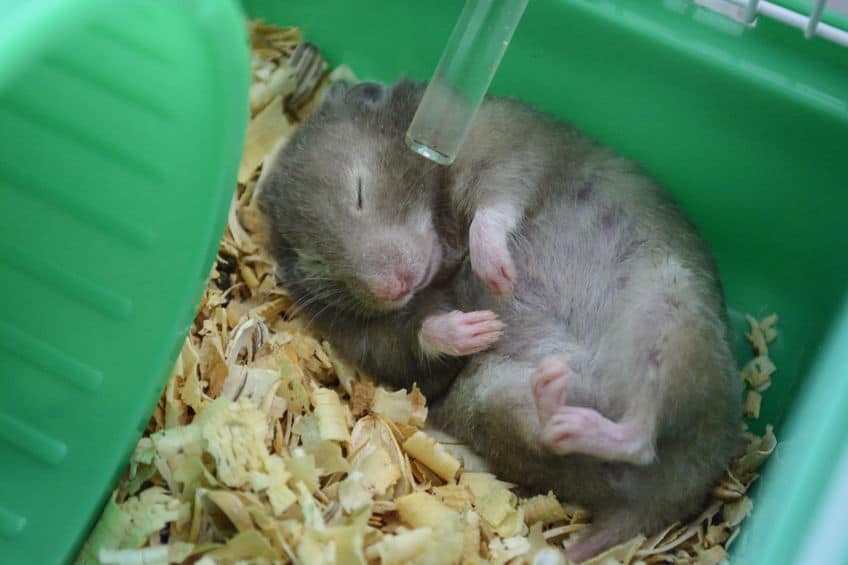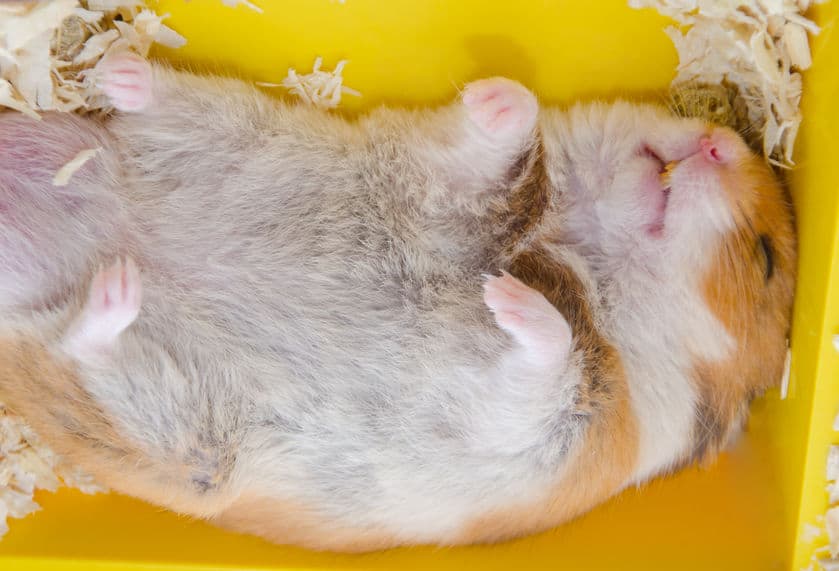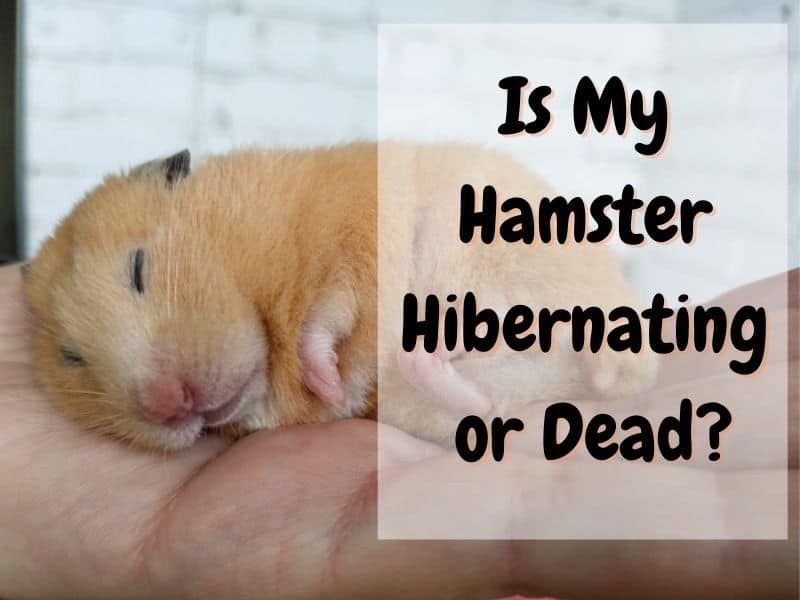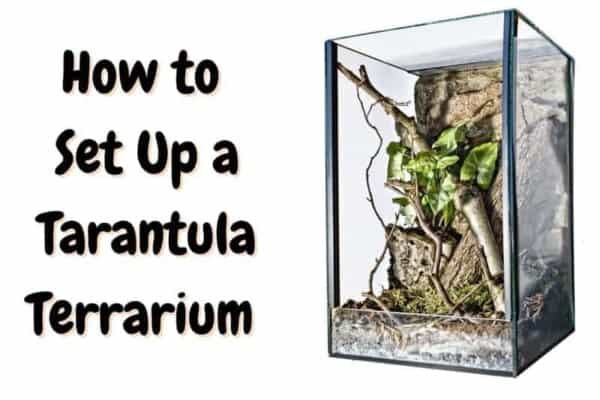If your pet hamster has been sleeping for an unusually long period of time, you may wonder whether he is hibernating or simply dead. This article will help you determine whether your critter is going through a period of hibernation or has unfortunately passed on. We will also discuss what hibernation looks like in hamsters and practical ways to keep your hamster safe and healthy during winter.
How to Know if Your Hamster is Hibernating or Dead
Here are a few things you can check to determine whether your hamster is hibernating or dead:
- Breathing: Hibernating hamsters will be seen in a deep sleep, breathing at a very slow rate and snoring sometimes. You might need to watch for a few minutes to see if your hamster is still breathing.
- Heartbeat: To check for a sleeping hamster’s heartbeat, gently place your thumb and forefinger on their chest and feel for movement. You should be able to feel their heart beating slowly if they’re still alive.
- Room temperature: Your hamster should not be hibernating if the room temperature is above 20°C. In case the cage was placed near an open window or in a chilly area of the room, increase the temperature gradually over 20°C – they should wake up within a few hours.
- Body temperature: Don’t rely exclusively on body heat since a hibernating hamster will lower his body temperature to match that of the environment.
- Twitching whiskers: If your hamster is still alive, you may be able to see that his whiskers are moving a little bit. It’s not always obvious, so you might need to watch your pet’s whiskers for a few minutes.
- Stiffness: Hamsters that have died may look like they’re hibernating but their body is stiff when you pick them up with no give at all. This is called rigor mortis, a physiological change that results in the stiffening of the body’s muscles. In addition, there might be fluids or blood coming from somewhere on the hamster’s head or back end of its body which means it is dead for sure.
See also: 8 signs your little hamster has unfortunately passed away
Do Hamsters Actually Hibernate?

Pet hamsters are not true hibernators, but they do enter a state of reduced activity during the cold months to conserve energy. This is called torpor or winter lethargy, and it happens if your hamster’s environment is cold or if they are not getting enough food.
There are certain signs that indicate whether or not your hamster has entered into a state of torpor:
- Activity level: Your pet will look inactive and will move around very little over time – usually sitting still with its eyes closed more often than usual.
- Body temperature: It will drop significantly while sleeping well- from about 37 degrees Celsius (98.61 Fahrenheit) to 26 degrees Celsius (78.84 Fahrenheit).
- Skin: Their skin on the back will become pale and dry while their genitals stay moist – this color change should be dark brown if it hasn’t entered into torpor yet.
- Weight loss: They will lose weight even though they are eating normally or have increased their food intake, which usually happens right before hibernation begins.
If your hamster seems to not eat, you can try giving them a few drops of honey water in their mouth. This will help them hydrate until spring comes when they return to being more active again. You may want to invest in an under-tank heater so that your hammy gets enough warmth during the colder months without it getting too hot for them.
How Do I Wake Up a Hamster in a State of Hibernation/Torpor?
If your hamster has gone into a state of torpor because of a sudden drop in temperature in the room where it is staying, there are a few practical steps you can take to wake up your pet hamster:
- Go slow. You must proceed slowly and gradually when waking up your hamster from a hibernating state since a sudden rise in temperature might be fatal.
- Increase the room temperature or move your hammy to a warmer room
- Use your own body temperature by cupping your hand around them and placing them on your chest
- Rub their backs. This will encourage blood flow circulation
- Seringe-feed your hamster electrolyte water(1 cup of warm water, 1/2 cup of sugar, 1 teaspoon of salt) once every two minutes for 30 minutes. This will help warm his body gradually from the inside.
- Place a heating pad or hot water bottle wrapped in a blanket inside your hamster cage
- Give them a little bit of warm food (porridge, scrambled eggs, boiled chicken)
What Time Of The Year Do Hamsters Hibernate?
Hamsters hibernate in the wild from October to April, when food is scarce and the weather is cold. In captivity, Hamsters typically enter a state of reduced activity from December through February, when the temperature drops and the sunlight is at its minimum.
If you live in an area where the winters are particularly harsh, your hamster may stay in torpor for a longer period of time. Hamsters start hibernating in cold temperatures, at around 50-60 degrees Fahrenheit. This is the temperature range where they are most comfortable and will not wake up from hibernation.
Do hamsters hibernate in summer?
No, hamsters do not hibernate in summer. They will only go into hibernation when the weather is right and they are ready. You don’t need to take any special precautions to care for your hamster during summer – just make sure its environment is cool and comfortable.
How Long Does Hamster Hibernation Last?

Hibernation can last anywhere from a few weeks up to several months depending on how cold it gets outside and where your hamster lives. If you live in an area with very mild winters or if you keep your home at a warm temperature during this time of year (around 70 degrees Fahrenheit), then your hamster may only need to be sleeping for around two weeks at most.
On the other hand, if you live in an area with cold temperatures (below freezing) and your hamster lives in a chilly room of the house (like an unheated basement), then it may go into hibernation for around four months.
This just goes to show that there are many different factors involved when it comes to whether or not an individual hamster will experience hibernation for a long or short period of time.
Hibernation is very different from deep sleep. During deep sleep, hamsters might twitch, run around in their bedding and make noise (because they are dreaming). With hibernation there is no movement or sound; your hamster’s chest will barely rise up and down as he breathes and it will be hard to tell if he is breathing at all.
Don’t let your hamster get too cold during the winter because it will need its energy stores in order to survive through the colder season and come out of hibernation safely.
How Can I Keep My Pet Hamster Warm During Winter?
There are a few things you can do to help make sure your hamster stays warm during winter:
- Room temperature: Keep their cage in a room that is not too hot or cold, ideally 65-75 degrees Farenheight
- Extra heat: You might also want to place the cage near a heater or radiator so they can get some extra warmth. You may also place a heating pad underneath the cage at a medium level to prevent excessive heat.
- Bedding: Make sure there’s extra bedding and nesting material in their cage so they can burrow down and keep warm. If your hamster seems cold, you can also place inside their habitat a hot water bottle wrapped in a towel to help heat them up.
- Food: You should also increase the amount of food they’re eating as they will need more energy to keep warm.
Do All Hamster Breeds Hibernate?
Yes, all breeds of hamsters can potentially hibernate depending on their environment and how cold it gets.
- Syrian hamsters do not typically hibernate in the wild, but they have been known to do so in captivity if their environment is cool enough. For this reason, a Syrian hamster is called a “facultative” or “permissive” hibernator.
- Russian dwarf hamsters and winter white dwarf hamsters tend to hibernate the longest.
- Roborovskii and Campbell’s breeds may also go into a prolonged sleep during the colder months.
- Chinese hamsters usually only enter a state of reduced activity from December through February.
How Do I Know When My Hamster is Done Hibernating?
When spring arrives and the weather starts to get warmer, you’ll start to see your hamster become more active again. They will usually start coming out of their burrows and exploring their surroundings more. The skin on their back will return to its normal color and they will begin eating more regularly.
In a cold climate, you may need to slowly increase the temperature in their environment over a few days until it’s comfortable for them. Once your hamster is back to its normal self, you can stop providing them with extra food and warmth.
Do Hamsters Hibernate With Their Eyes Open?
No, hamsters do not hibernate with their eyes open. During the winter, they will burrow down in a nice comfortable nest and go to sleep for several weeks or even months at a time. This is when you might notice your hamster’s eyes are closed more often than usual – don’t worry though, this can happen during summer too. Their natural instincts make them want to close their eyes tightly while they’re sleeping so no light gets in.
Are All Rodents Hibernating Animals?
No, not all rodents are hibernating animals. There are some species of rodents like chipmunks and squirrels who live outside year-round and don’t hibernate. However, there are many other types of rodent pets like mice, rats, chinchillas, and gerbils who do go into hibernation in order to survive the winter months when food is scarce.
Read also
- Top 200 Cute and Fun Hamster Names
- Is the Ferplast Favola Cage a good Hamster Cage?
- Are hamster balls safe?
Contents
- How to Know if Your Hamster is Hibernating or Dead
- Do Hamsters Actually Hibernate?
- How Do I Wake Up a Hamster in a State of Hibernation/Torpor?
- What Time Of The Year Do Hamsters Hibernate?
- How Long Does Hamster Hibernation Last?
- How Can I Keep My Pet Hamster Warm During Winter?
- Do All Hamster Breeds Hibernate?
- How Do I Know When My Hamster is Done Hibernating?
- Do Hamsters Hibernate With Their Eyes Open?
- Are All Rodents Hibernating Animals?













